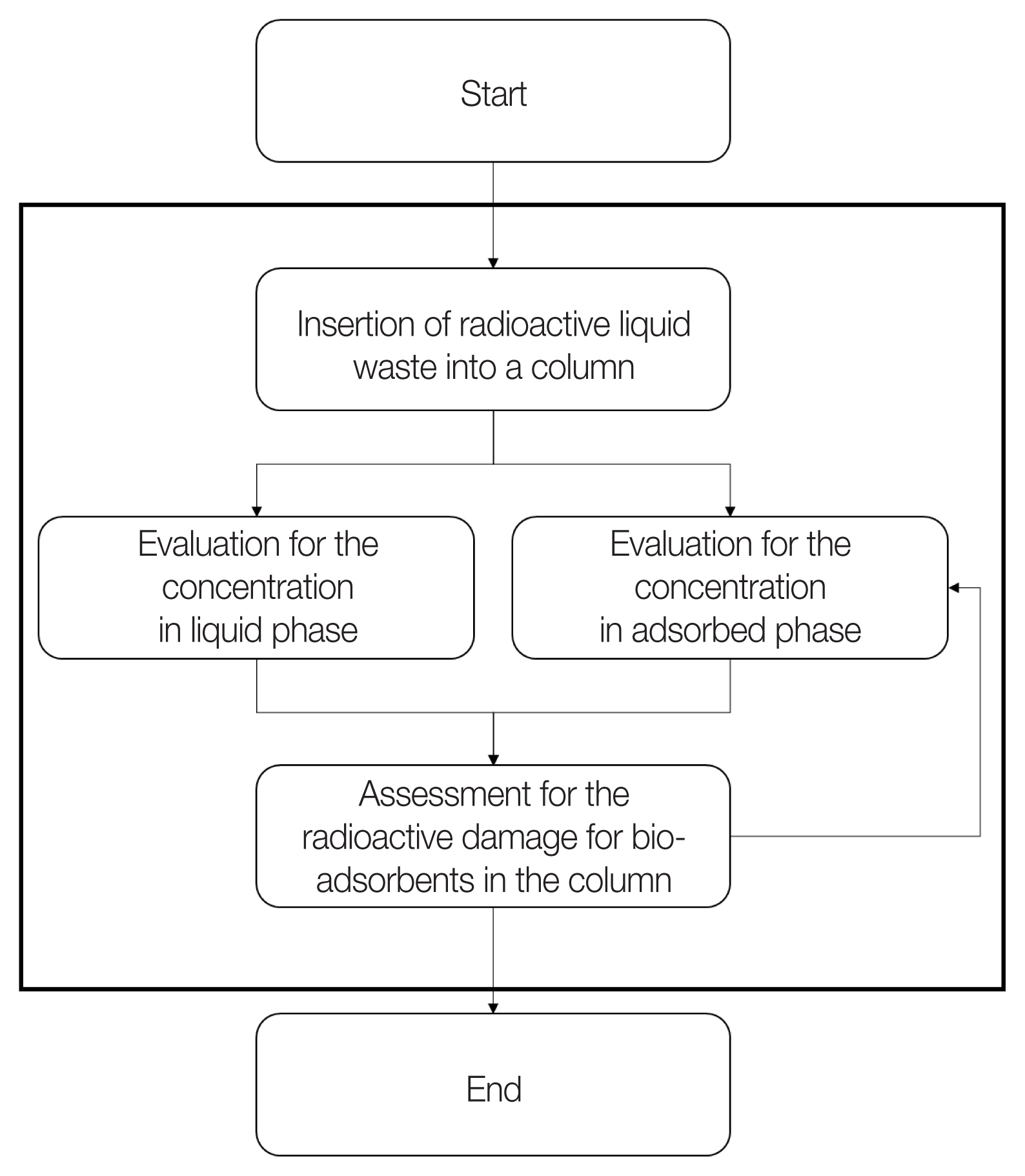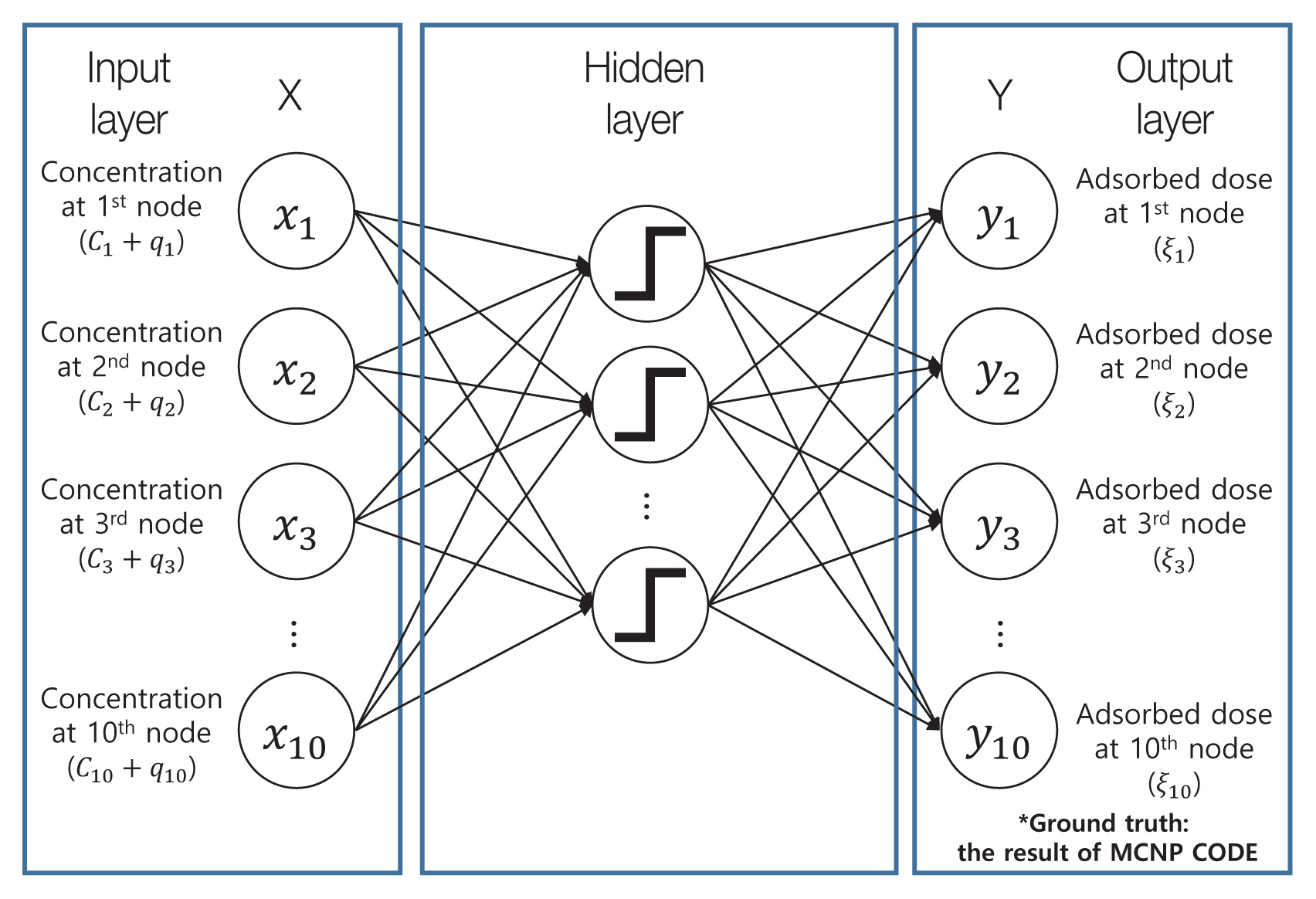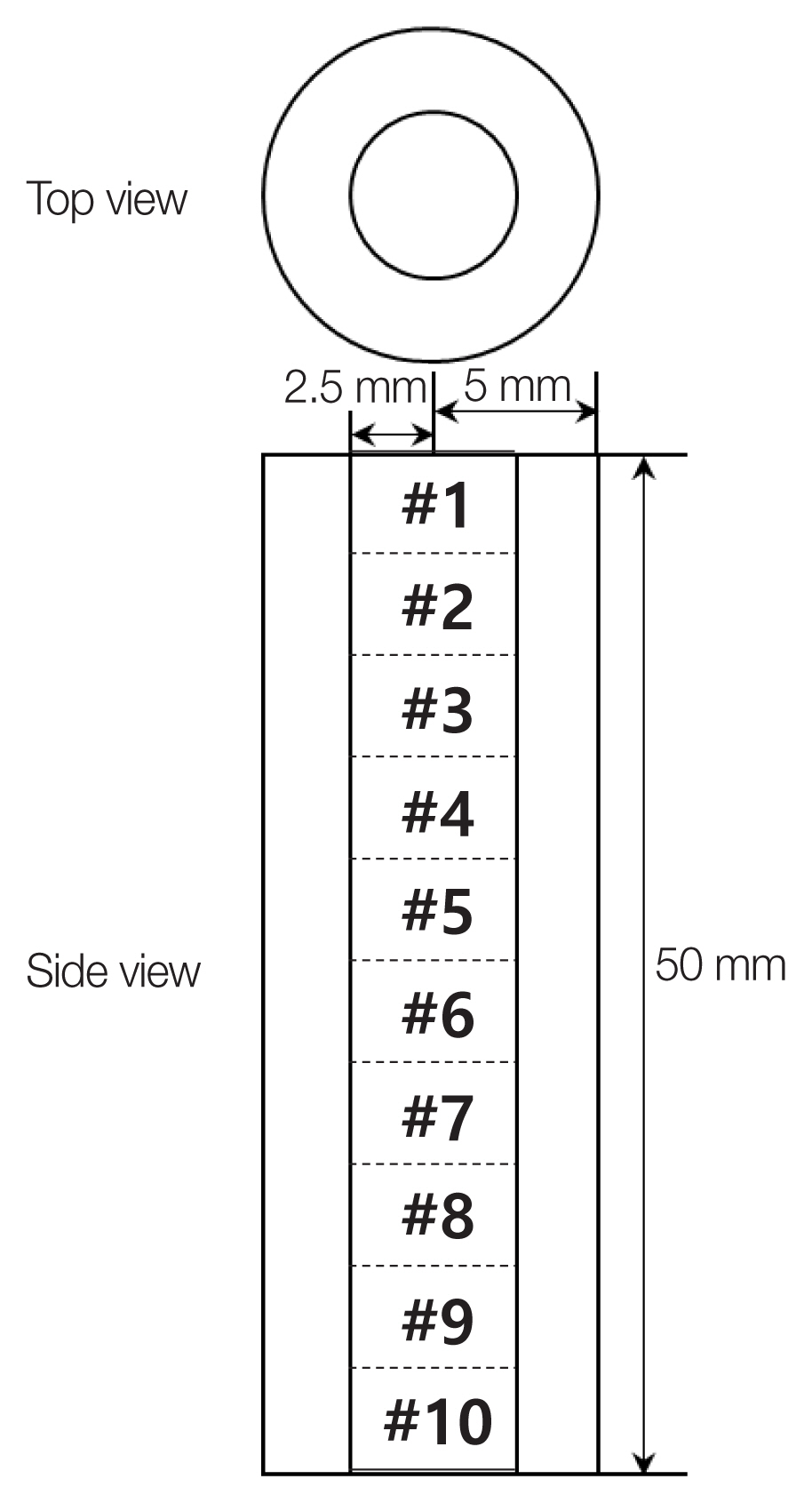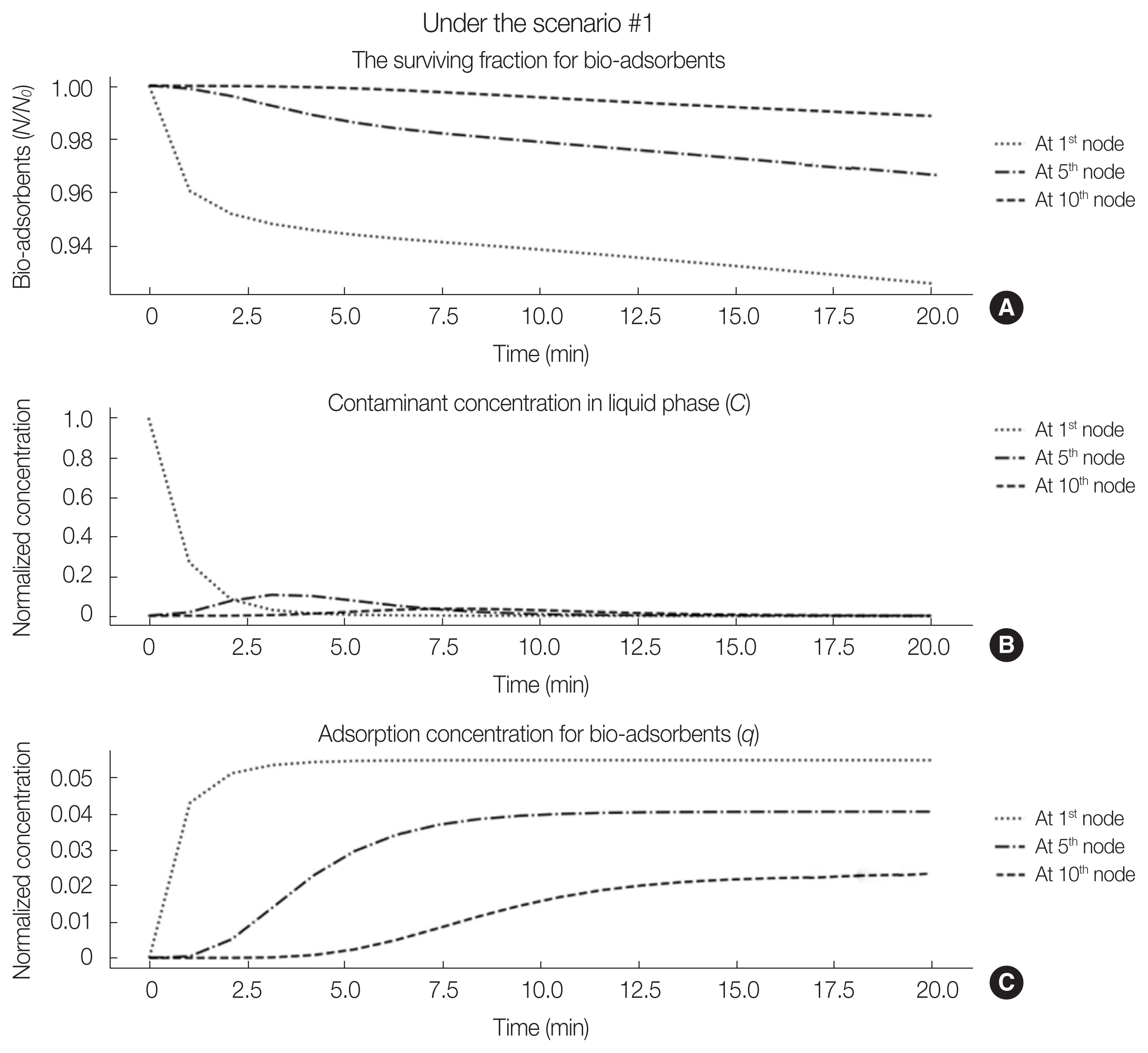AbstractBackgroundRecently, biological adsorbents have been developed for removing radionuclides from radioactive liquid waste due to their high selectivity, eco-friendliness, and renewability. However, since they can be damaged by radiation in radioactive waste, a method for estimating the bio-adsorbent performance as a time should consider the radiation damages in terms of their renewability. This paper aims to develop a simulation method that applies a deep learning technique to rapidly and accurately estimate the adsorption performance of bio-adsorbents when inserted into liquid radioactive waste.
Materials and MethodsA model that describes various interactions between a bio-adsorbent and liquid has been constructed using numerical methods to estimate the adsorption capacity of the bio-adsorbent. To generate datasets for machine learning, Monte Carlo N-Particle (MCNP) simulations were conducted while considering radioactive concentrations in the adsorbent column.
IntroductionTo decrease the radioactivity in radioactive wastes and reduce the radiation doses of workers during the decommissioning of nuclear power plants (NPPs), related equipment and structures should be decontaminated. A large volume of liquid radioactive waste can be generated by decontamination processes or the disposal of various contaminated materials during the operations of NPPs. Its treatment and management have been a great concern in countries that have NPPs [1].
Various treatment processes can be used to dispose of liquid radioactive waste generated by NPP decontaminations, including ion exchange, chemical precipitation, reverse osmosis, evaporation, filtration, and solvent extraction [2–4]. Recently, many methods to remove radionuclides using biological adsorbents (bio-adsorbents) have been noticed in terms of their advantages of high selectivity, eco-friendliness, and renewability [5–7]. The renewability of bio-adsorbents offers cost-effectiveness, but their removal performance can be impaired by radiation in terms of the selection of specific radionuclides [8, 9].
Therefore, the radionuclide removal performance and radiation damage should be considered at the same time in order to elaborately evaluate the recovery rate of bio-adsorbents. Several methods can be used to evaluate the radionuclide removal performance for bio-adsorbents [10, 11], but these methods cannot efficiently evaluate radiation damage as a time-dependent phenomenon while considering conditions that rapidly change by the decommission environment of NPPs. Although damages to bio-adsorbents because of radiation are evaluated by particle transport codes (e.g., Monte Carlo N-Particle [MCNP]), the computation cost is high because estimations should be repeatably performed at each time step.
Recent machine learning techniques have been developed to evaluate complex data relationships, enabling rapid and accurate performance assessment [12]. A significant portion of this recent success can be attributed to the availability of large training datasets and well-designed models. However, it is difficult and expensive to collect datasets covering all possible scenarios for evaluating the bio-adsorbent performance; hence, it is challenging to evaluate the damages of bio-adsorbents using a machine learning-based model.
To overcome the issues in evaluating the performance of a bio-adsorbent, this paper proposes a method to automatically estimate the removal performance while considering radiation damage using an artificial neural network (ANN) and an advection-dispersion equation (ADE). After establishing the performance evaluation procedures, the ANN for radiation damage estimation is introduced while considering its high accuracy and low computing resources. After conducting machine learning with the datasets obtained through the MCNP simulation [13], the bio-adsorbent performance is estimated using the proposed method. The results are compared with those of the MCNP simulation.
Materials and Methods1. Estimation Overview
Fig. 1 shows a bio-adsorbent removal example for radionuclides in liquid radioactive waste in a column that contains a bio-adsorbent when the liquid radioactive waste is injected into the top of the column, and the purified liquid is extracted through the bottom. During radionuclide transport into the column, specific target ions are selectively captured by the bio-adsorbent through the diffusion process, and the rest move down by advection. Additionally, some reactions occur (e.g., dispersion and radioactive decay) in liquid radioactive waste. Meanwhile, the bio-adsorbent desorbs the adsorbed target ions and is damaged by the ionizing radiation of radionuclides.
The radiation damage to the bio-adsorbent is mainly governed by the radionuclides contained in the liquid and captured in it. It causes a reduction in the adsorption performance of the bio-adsorbent. Therefore, contaminant concentrations of radionuclides considering the abovementioned two phases obtained using a transport model should be considered to evaluate the time-dependent adsorption performance of bio-adsorbents with radiation damage (Fig. 2). In this study, the ADE with Langmuir isotherm adsorption is introduced to evaluate the contaminant concentration in the liquid and adsorbed phases. Further, an ANN model is developed and applied to improve the estimation time of radiation damages during the ADE simulation.
2. One-Dimensional Advection-Dispersion Equation with Langmuir Isotherm AdsorptionFor the simulation of radionuclides captured by the bio-adsorbent as porous adsorbent media, the following conditions are assumed: (1) the velocity, temperature, and pressure are constant when injected into liquid waste with one-dimensional (1D) flows; (2) an ideal fluid behavior is followed; (3) no mass transfer resistance emerges between the liquid and adsorbed phases; and (4) the capture in the adsorbed phase is given by Langmuir isotherm. The desired 1D ADE with adsorption can be expressed as follows [14]:
where t denotes time, z is the spatial coordinate from up to down in this study, θ is porosity, ρb is bulk density (kg/m3), C is the contaminant concentration in liquid waste, q is the adsorbed amount in the media, v is the linear average velocity of liquid waste (m/s), D is the dispersion coefficient in a column (m2/s), λ is the decay constant of radionuclides (s−1), and γ(z) is the production term by insertion of liquid waste into the column. Meanwhile, the adsorption kinetics equation based on Langmuir isotherm is expressed as follows [14]:
where k1 is the adsorption constant (s−1), k2 is the desorption constant (s−1), and qmax is the adsorption capability of the media. To collect the dataset from the above hypothesis, numerical methods are applied to Equations (1) and (2). Equation (2) is derived as follows using an explicit finite difference method:
Similarly, using the implicit scheme from Equation (1), Equation (4) can be expressed as follows:
(4)Finally, by substituting Equation (3) into Equation (4), the following equation can be obtained:
(5)where
3. Estimation Model of Radiation Damage for Biological AdsorbentsIt is assumed that the adsorption performance depends on the number of surviving bio-adsorbents in the irradiated environment. Also, in a preliminary study [15], the number of damaged bio-adsorbents linearly varied with the radiation dose. With the assumption of the linear variation, the number of surviving bio-adsorbents can be negative; hence, the max(a,b) function, which replaces negative values with 0, was used in this study. To represent this, let
where ra is the bio-adsorbent loss rate of radiation damage per absorbed dose (#/Gy), and ξij is the adsorbed dose by a radiation damage model (Gy). Here, the total contaminant concentration, including in the liquid and adsorbed phases, is utilized to estimate the adsorbed dose ξij. Therefore, by letting
In a previous study [15], the relationship between the absorbed dose and damages of bio-adsorbents were evaluated. To calculate Equation (7), the radioactive source is assumed to be uniformly located in each column divided for the partial damage analysis; F4 tally with the Monte Carlo N-Particle code version 6 (MCNP6) code is used for estimating the absorbed dose. The dose energy function card from International Commission on Radiological Protection 74, which provides conversion coefficients for air kerma per unit fluence of monoenergetic photons, is utilized to directly convert the flux into the dose rate [16]. The normalized concentration of each column estimated using Equation (6) is applied to the source probability as the MCNP input. In Equation (6), ξij is calculated by multiplying Δt by the absorbed dose rate. The other input values for the MCNP simulation are fixed during the simulation, except for the concentration information in the column.
4. Artificial Neural Network for Radiation Damage EstimationThe ANN, which is developed by referring to biological neurons, is a type of machine learning method used for prediction or classification. It has many advantages, such as real-time operation, adaptive learning and, the ability to easily analyze complex mathematical problems. Fig. 3 shows an ANN architecture comprising an input layer, wherein input features should be the information of the radioactive concentration from the liquid waste and bio-adsorbent of the column; hidden layer, including a non-linear activation function; and output layer, which predicts the adsorbed dose affected by the concentration information.
In this study, as illustrated in Table 1, the neural network consists of five fully connected layers, each activation function of the hidden layer is the “rectified linear unit (ReLU)” function, and the optimizer in the neural network is Adam with weight decay (ADAMW) [17], of which the learning rate and weight decay are 1×10−3 and 1×10−7, respectively. The loss function between the results of the neural network model and MCNP simulation was determined based on the mean squared error (MSE). A total of 500,000 normalized concentration samples were randomly collected to perform the deep learning model and were then divided into three categories: 400,000 training data, 50,000 validation data, and 50,000 test data. Using the simulation dataset, the ANN model in this study was trained by 1,000 epochs within 3 hours of running time (NVIDIA Tesla V100). The deep learning model was implemented using Tensorflow 2.0 (Google LLC), supported by Python 3.6 (Python Software Foundation).
Results and Discussion1. Simulation Results and AnalysisIn this simulation, 60Co, which emits higher energy than other radionuclides, was selected only from in the liquid radioactive waste. It was assumed that the radionuclides were injected into the top of the column as the initial condition to run the simulation. The simulation is terminated after all the purified liquid waste passes through the bottom of the column.
Depending on the experimental environment (e.g., sequence of bio-adsorbent and type or concentration of radionuclides), the simulation scenario, including adsorption and radiation damage to bio-adsorbent such as aptamers comprising short sequences of artificial DNA or RNA molecules, would be subject to change [18]. The adsorption rate, desorption rate, and adsorption capacity of the bio-adsorbent could be determined under various adsorption experiments [19]. Meanwhile, the damage coefficient of the bio-adsorbent could be estimated through the Monte Carlo damage simulation code, which can evaluate radiation-induced DNA damage linked with MCNP.
The contaminant concentration of liquid radioactive waste C, adsorption of bio-adsorbent q, and survival rate of bio-adsorbent are defined under the condition of adsorption rate k1. Table 2 summarizes the bio-adsorbent loss rate of radiation damage per absorbed dose ra by the present adsorption kinetic model with radiation damage discussed in Section 2 and the parameters used in this study. The concentration values were evaluated with the length L of 5 cm, and during the operating time T=20 minutes, the input values are Δt=0.01 (min), Δz=0.5 (cm), Ci0=δi0, (qmax)i0=0.1 (for 1≤i≤10), v=0.49 (cm/min), D=0.03 (cm2/min), θ=0.7, λ=2.48×10−7 (min−1), k2=1×10−6 (min−1), and ρb=1.11 (g/cm3). Here, δi0 denotes the Kronecker delta function, which is defined as 1 when i=0 and 0 for all other values of i. The radius and height of the column should be 2.5 and 50 mm, and the column is divided into 10 nodes (Fig. 4). Table 3 summarizes the necessary information of the input variables for the MCNP code (e.g., density and molecular composition). In each MCNP simulation, the number of particle histories is selected to 100,000, which shows a relative error of the dose under 1.5%.
Fig. 5 presents the results for the cumulative survival and adsorption concentration of the bio-adsorbent and contaminant concentration in the liquid phase at the top, middle, and bottom nodes in scenario #1 with liquid waste insertion, including 60Co. From Fig. 5B, the contaminant concentration at the top node was initialized with a normalized concentration of 1.0 because of the injection of liquid radioactive waste, then decreased due to advection, adsorption, and dispersion, and finally converged to 0. Similarly, the concentrations at the middle and bottom nodes temporarily increased due to advection and, then, decreased due to advection and adsorption. From Fig. 5C, each level of adsorption concentration converged because the Langmuir adsorption equation was assumed. Then, the survival fraction of the bio-adsorbent shown in Fig. 5A is derived by calculating the radiation damage induced by radioactive concentration from the liquid radioactive waste and bio-adsorbent of the column using the results from Fig. 5B and 5C.
The survival fractions of the bio-adsorbent for the whole bio-adsorbent were estimated (Fig. 6). If the bio-adsorbent has no radiation damage similar to that of scenario #4 (ra=0), the number of bio-adsorbent is fixed. The variation of the adsorption rate k1 rarely affects the survival rate because the difference of the curves from 1 to 3 among the scenarios is small, whereas the survival fraction decreases drastically when ra is increased from 4 to 6 among the scenarios. Therefore, the results demonstrate that the survival ratio for the bio-adsorbents directly depends on ra, rather than on k1. However, the inference time for testing a scenario case, which has 2,400 frames, was about 45 minutes. It is found that the process for evaluating radiation damage by MCNP mainly results in bottleneck phenomena.
2. Verification of the ANN Damage Analysis ModelThe prediction accuracy of ANN models, compared with the results of the MCNP simulation, was evaluated:
MSE:
Mean absolute percentage error (MAPE):
Coefficient of determination (R2) score:
where
As the MCNP simulation is a stochastic method, the datasets include uncertainties. It is noted that the ANN trained with the uncertain datasets provides an average value [20]. Therefore, as a preliminary study, the uncertainty of the dataset is not mainly considered in this study. During the training phase of the ANN model, the loss functions for the training and validation data have converged to near zero, and overfitting has not occurred as the differences between training and validation losses were small (Fig. 7). To evaluate the performance of the presented simulations that correspond to the presented values concerning the two main parameters of the model (i.e., k1 and ra), four metrics are measured: MSE, R2 score, MAPE, and inference time. Compared with the ANN and MCNP, the results with the test data agree well (Table 4). The R2 score shows 99.3% accuracy and MAPE indicates 0.062% accuracy. Meanwhile, the average inference speed of the ANN is approximately 0.031 second per a frame, which is approximately 30 times faster than that of the MCNP model (i.e., 1.01 second per a frame). As confirmation of the replacement performance, the sample results of the simulation using the ANN model show that the error range with the MCNP model is up to 0.002, and the average of the errors is at the 1×10−5 scale (Fig. 8).
ConclusionThis study developed a method of radioactive damage estimation for the bio-adsorbent with the ADE using implicit and explicit schemes from the numerical method. Furthermore, a relatively fast ANN model was replaced with a radiation transport simulation code (e.g., MCNP). The ANN model was proposed to increase accuracy and inference speed. A total of 500,000 random sample data were generated through the MCNP simulation, and machine learning was conducted. According to the simulation results, the ANN model and MCNP simulation are analogous in terms of the accuracy of 99.3% and 0.062% in the R2 score and MAPE, respectively. The inference time can be reduced to 74 seconds, and the MCNP code evaluated 2,400 frames within 44 minutes. Note that the performance can be optimized to estimate the damage from radioactive materials, and whether bio-adsorbents can be reused should be determined accurately and quickly by using the advantages of the ANN. As a further study, the development of bio-adsorbents would be accelerated to contribute to the maintenance and utilization of decontaminant processes for NPPs.
As shown in the results and analyses, the method proposed in this study gives a clue for real-time performance evaluation of the bio-adsorbents caused by irradiation during the time-dependent decommission process of liquid radioactive wastes; however, there are several limitations: (1) the uncertainty of datasets obtained by MCNP simulations is not sufficiently verified, (2) the proposed method cannot evaluate the uncertainty. Thus, the error and uncertainty should be evaluated for application in the decommissioning process in future work.
NotesConflict of Interest Joo Yeon Kim, Sangsoo Han, Sung Gyun Shin, and Song Hyun Kim serves SierraBASE Co. Ltd.; however, no potential conflict of interest relevant to this article was reported. Ethical Statement This article does not contain any studies with human participants or animals performed by any of the authors. Author Contribution Conceptualization: Yun M, Kim SH. Methodology: Lee J, Jang S, Lee MJ, Cho WS, Lee SY, Jang DH. Project administration: Kim SH. Visualization: Lee J. Writing - original draft: Lee J. Writing - review & editing: Kim JY, Han S, Shin SG, Kim SH. Approval of final manuscript: all authors. AcknowledgementsThis work was supported by Korea Hydro & Nuclear Power Co., Ltd. (No. 2020-Tech-14), the Korea Institute of Energy Technology Evaluation and Planning (KETEP) grant funded by the Korea government (MOTIE) (20203210100390, Development of Eco-friendly Biomaterial to Improve the Treatment Performance of Radioactive Liquid Waste from Decommissioning) and the National Research Foundation of Korea (NRF) with the funding of the government (Ministry of Science and ICT) (No. 2021M2D2A20184452161082139290201).
References1. Liao Z, Chen Z, Xu A, Gao Q, Song K, Liu J, et al. Wastewater treatment and reuse situations and influential factors in major Asian countries. J Environ Manage. 2021;282:111976.
2. Adbel Rahman RO, Ibrahium HA, Hung YT. Liquid radioactive wastes treatment: a review. Water. 2011;3(4):551-565.
3. Goutam Mukherjee A, Ramesh Wanjari U, Chakraborty R, Renu K, Vellingiri B, George A, et al. A review on modern and smart technologies for efficient waste disposal and management. J Environ Manage. 2021;297:113347.
4. International Atomic Energy Agency. Handling and processing of radioactive waste from nuclear applications. IAEA. 2001.
5. Hassan SSM, Kamel AH, Youssef MA, Aboterika AHA, Awwad NS. Removal of barium and strontium from wastewater and radioactive wastes using a green bioadsorbent, Salvadora persica (Miswak). Desalin Water Treat. 2020;192:306-314.
6. Jang DH, Lee SY, Kim H, Yun M. Development of a method for radioactive nickel removal. Transactions of the Korean Nuclear Society Autumn Meeting. 2022 Oct 20–21. Changwon, Korea.
7. Fuks L, Oszczak A, Dudek J, Majdan M, Trytek M. Removal of the radionuclides from aqueous solutions by biosorption on the roots of the dandelion (Taraxacum officinale). Int J Environ Sci Technol. 2016;13(7):2339-2352.
8. Borrego-Soto G, Ortiz-López R, Rojas-Martínez A. Ionizing radiation-induced DNA injury and damage detection in patients with breast cancer. Genet Mol Biol. 2015;38(4):420-432.
9. Becker D, Sevilla MD. The chemical consequences of radiation damage to DNA. Adv Radiat Biol. 1993;17:121-180.
10. Ding C, Cheng W, Sun Y, Wang X. Novel fungus-Fe3O4 bio-nanocomposites as high performance adsorbents for the removal of radionuclides. J Hazard Mater. 2015;295:127-137.
11. Hidouri S. Possible domestication of uranium oxides using biological assistance reduction. Saudi J Biol Sci. 2017;24(1):1-10.
12. Veza I, Afzal A, Mujtaba MA, Hoang AT, Balasubramanian D, Sekar M, et al. Review of artificial neural networks for gasoline, diesel and homogeneous charge compression ignition engine. Alex Eng J. 2022;61(11):8363-8391.
13. MCNP Team. MCNP6.2.0 Release testing: LA-UR-17-29011. Los Alamos National Laboratory. 2017.
14. van Kooten JJA. A method to solve the advection-dispersion equation with a kinetic adsorption isotherm. Adv Water Resour. 1996;19(4):193-206.
15. Lee M, Cha G, Kim D, Yun M, Jang D, Lee S, et al. Evaluation of radiological effects on the aptamers to remove ionic radionuclides in the liquid radioactive waste. J Radiat Prot Res. 2023;48(1):44-51.
16. International Commission on Radiological Protection. Conversion coefficients for use in radiological protection against external radiation. ICRP Publication 74. Ann ICRP. 1996;26(3–4):1-205.
17. Loshchilov I, Hutter F. Decoupled weight decay regularization. arXiv 2017. Nov. 14. [Preprint]. Available from: https://doi.org/10.48550/arXiv.1711.05101
18. Katilius E, Flores C, Woodbury NW. Exploring the sequence space of a DNA aptamer using microarrays. Nucleic Acids Res. 2007;35(22):7626-7635.
Fig. 1Example of interactions for radionuclides between liquid and bio-adsorbents in the column under insertion of liquid radioactive waste. 
Fig. 2Process for evaluating the radioactive amount in a column including liquid and bio-adsorbents under insertion of liquid radioactive waste. 
Fig. 3Architecture of an artificial neural network by radioactive information from Monte Carlo N-Particle (MCNP). 
Fig. 4Monte Carlo N-Particle (MCNP) modeling of a column containing some bio-adsorbents and liquid radioactive waste. 
Fig. 5Example of simulated results under scenario #1: (A) surviving fraction for bio-adsorbents, (B) contaminant concentration in liquid phase, and (C) adsorption concentration for bio-adsorbents. 
Fig. 8(A–F) Differences of cumulative survival rate between artificial neural network and Monte Carlo N-Particle (MCNP) for the six scenarios (#1–#6) given in this study. 
Table 1The Hyperparameters Utilized in the Artificial Neural Networks Table 2The Variation of Model Parameters under the Scenarios
Table 3The Specification for the Experimental Scenario to Utilize MCNP Code Table 4Comparison with Artificial Neural Network and MCNP Code from Test Data Obtained by Random Sampling |
|
||||||||||||||||||||||||||||||||||||||||||||||||||||||||||||||||